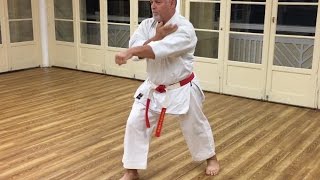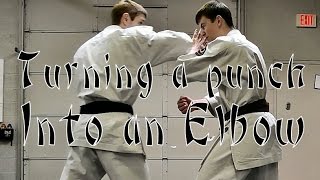This is not my video, but it demonstrates the 'brush' block seen in the Isshinryu version of Wansu kata.
At roughly 16 seconds in, you see the first such block.
For someone accustomed to the more traditional low, medium, and high blocks, it may seem strange at first, but it is loaded with potential applications and to me, it is a delight to work. It utilizes body shifting, unconventional stances, and seeks strategic openings in the opponent's defenses.
It begins by stepping forward and using an open hand block with the right, as if one were signalling someone to stop. The basic application for this is that it blocks a straight punch to the head by intercepting and deflecting it to the attacker's left; it can be used to deflect a punch from either side, as the block crosses the defender's center.
In the basic application, the attacker, having had their punch deflected with the open hand, immediately fires off another straight punch to the head. This is when the open-handed block is used to 'sweep' towards the defender's left shoulder.
The sweep can be used for a variety of purposes, whether or not the attacker actually threw a punch that needed to be deflected with it. Note that as the sweep moves, the defender extends their left hand about belt-high towards the attacker. In the basic application, this would grasp the attacker by the belt, clothing, roll of fat, etc, and immediately, the defender steps to the right with the left leg, getting off the fight line and taking a non-common hook or kake dachi stance. See the stance below - I am just referring to the feet, not the position of the karateka's arms in this photo (not my photo):

This stance is excellent, in my opinion, because it gives a stable base to pull or avoid being pulled. Try it sometime; take the stance, sink into it so that both knees are slightly bent, and have someone take your arm and pull you off-balance. If you resist by allowing the knee of the leg in back to press into the back of the knee in front, and accept the pulling motion as a way to tighten the stance, you can be quite stable from that direction.
Now, consider that as you stepped into the hook stance, you had hold of the attacker's belt, roll of fat, whatever you could grab with your left hand. You sink into your stance and pull that arm towards you. This should have the effect of pulling the attacker towards you and off-balance, since you are pulling from one of their balance points.
At that moment, strike. Left hand pulls, right hand punches. To punch, of course, the right hand, which had been in a sweeping gesture over the left shoulder, has to return. There is much opportunity here to use it for a variety of things.
Since the hand is open, it can be used to chop the neck if it is within range. If the attacker's head and neck are not close enough, the open hand can be closed into a hammer fist and used on basically anything in range, including any attempts the attacker makes to punch again, as a block, but a 'bang' style block, which immediately bounces into a punch of its own.
However, if you just take the sweeping block illustrated in the video above at 16 seconds in, and reinterpret it as a block / strike / strike with no other parts of the kata used, it's pretty sweet. Punch comes in, you cross your right towards your left shoulder to block or parry it. At the same time, your own left becomes a straight punch to the kidneys, solar plexus, hip / balance point, or etc. The point is that it is a low punch, and it moves at the same time as the block.
This also takes you into a cross-armed kamae position, with your right arm raised and your left arm lowered, crossing slightly on the left side. From here, you can block up, center, or down in an x-type block or strike. You can unload the cocked right hand as a hammer or a chop anywhere it fits, such as a hammer to the temple or nose, a chop to the side of the neck, and the moment you unload that right hand, you're now in a kamae to the right side, still protecting yourself.
I love to play with this part of the kata. People talk about the 'secret' moves in karate. These are not secrets, because I am certain they have all been explored, tested, modified, tested again, and passed on to many students in many styles over the years. They are secrets only in that if you don't get them taught to you, or don't explore and discover them on your own, they are as good as being secrets.
Here is an example of the 'brush block' being used in a slightly different way, note the strike with the left hand instead of a 'grab' of a belt, etc.

And again:

Here's a nice video, we see it again at 27 seconds in:
Look what he does at 28 seconds as a followup to the deflected strike!
Anyway, it goes on and one what you can do with this one defensive move in one kata.
Comments welcome, as always. These are not my videos or my photos - just posting examples found on the web.
At roughly 16 seconds in, you see the first such block.
For someone accustomed to the more traditional low, medium, and high blocks, it may seem strange at first, but it is loaded with potential applications and to me, it is a delight to work. It utilizes body shifting, unconventional stances, and seeks strategic openings in the opponent's defenses.
It begins by stepping forward and using an open hand block with the right, as if one were signalling someone to stop. The basic application for this is that it blocks a straight punch to the head by intercepting and deflecting it to the attacker's left; it can be used to deflect a punch from either side, as the block crosses the defender's center.
In the basic application, the attacker, having had their punch deflected with the open hand, immediately fires off another straight punch to the head. This is when the open-handed block is used to 'sweep' towards the defender's left shoulder.
The sweep can be used for a variety of purposes, whether or not the attacker actually threw a punch that needed to be deflected with it. Note that as the sweep moves, the defender extends their left hand about belt-high towards the attacker. In the basic application, this would grasp the attacker by the belt, clothing, roll of fat, etc, and immediately, the defender steps to the right with the left leg, getting off the fight line and taking a non-common hook or kake dachi stance. See the stance below - I am just referring to the feet, not the position of the karateka's arms in this photo (not my photo):

This stance is excellent, in my opinion, because it gives a stable base to pull or avoid being pulled. Try it sometime; take the stance, sink into it so that both knees are slightly bent, and have someone take your arm and pull you off-balance. If you resist by allowing the knee of the leg in back to press into the back of the knee in front, and accept the pulling motion as a way to tighten the stance, you can be quite stable from that direction.
Now, consider that as you stepped into the hook stance, you had hold of the attacker's belt, roll of fat, whatever you could grab with your left hand. You sink into your stance and pull that arm towards you. This should have the effect of pulling the attacker towards you and off-balance, since you are pulling from one of their balance points.
At that moment, strike. Left hand pulls, right hand punches. To punch, of course, the right hand, which had been in a sweeping gesture over the left shoulder, has to return. There is much opportunity here to use it for a variety of things.
Since the hand is open, it can be used to chop the neck if it is within range. If the attacker's head and neck are not close enough, the open hand can be closed into a hammer fist and used on basically anything in range, including any attempts the attacker makes to punch again, as a block, but a 'bang' style block, which immediately bounces into a punch of its own.
However, if you just take the sweeping block illustrated in the video above at 16 seconds in, and reinterpret it as a block / strike / strike with no other parts of the kata used, it's pretty sweet. Punch comes in, you cross your right towards your left shoulder to block or parry it. At the same time, your own left becomes a straight punch to the kidneys, solar plexus, hip / balance point, or etc. The point is that it is a low punch, and it moves at the same time as the block.
This also takes you into a cross-armed kamae position, with your right arm raised and your left arm lowered, crossing slightly on the left side. From here, you can block up, center, or down in an x-type block or strike. You can unload the cocked right hand as a hammer or a chop anywhere it fits, such as a hammer to the temple or nose, a chop to the side of the neck, and the moment you unload that right hand, you're now in a kamae to the right side, still protecting yourself.
I love to play with this part of the kata. People talk about the 'secret' moves in karate. These are not secrets, because I am certain they have all been explored, tested, modified, tested again, and passed on to many students in many styles over the years. They are secrets only in that if you don't get them taught to you, or don't explore and discover them on your own, they are as good as being secrets.
Here is an example of the 'brush block' being used in a slightly different way, note the strike with the left hand instead of a 'grab' of a belt, etc.

And again:

Here's a nice video, we see it again at 27 seconds in:
Look what he does at 28 seconds as a followup to the deflected strike!
Anyway, it goes on and one what you can do with this one defensive move in one kata.
Comments welcome, as always. These are not my videos or my photos - just posting examples found on the web.
